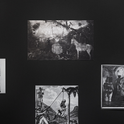When the Globe opened on the South Bank of the Thames in 1997, it was feared that the place would become a Bard-u-like money-making visitor attraction. Yet today the Globe is part of the theatrical landscape in every sense. The building, resembling at a distance a thatched Polo mint, nestles up to the Tate Modern with which it competes for custom. It is about to launch its summer season of six plays, "The Edges of Rome," with Coriolanus. Its Inigo Jones indoor theatre will open in three to four years, offering the possibility of winter seasons. The place is a catalyst in the South Bank's regeneration, an area of London that is today stuffed with more theatres, actors and tourists than at anytime since its sex industry heyday in the 1600s.
The fact that it exists at all is down to the visionary American actor Sam Wanamaker, who as a student saw a play at the reduced-scale replica Globe at the Chicago World's Fair in 1934 and in later life pursued a 30-year dream—in the face of indifference and mockery in Britain—to get a new Globe built on its original site (or near it—the original site is under a listed Georgian terrace) on Bankside. He died in 1993 and never saw the building finished. But now his Globe is part of the recent upswing of interest in Shakespeare (reflected also in this year's Royal Shakespeare Company plan to produce all the plays) and Wanamaker's re-creation has started a craze for "olde" theatres: various other Globe and Rose theatres are currently being built around the world, though most of them will have roofs.
The actor Mark Rylance, as the Globe's inaugural artistic director, aimed to shake hands with the past by occasionally re-creating Elizabethan stage practices—all-male versions, archaic terminology, even actors in Tudor underwear. Rylance's eccentric blend of mystical and scholastic experiment produced results from the sublime to the ridiculous. But he steered the theatre away from a fake merrie England style into a place of real pioneering. Dominic Dromgoole, the new artistic director, was an unexpected appointment from the world of new writing. He argues that the Globe has been from its outset a victim of snobbery and critical hostility. "Lots of directors, writers and actors don't come near the place. They see it as beneath them—and naff. The Globe talks directly to its audience in a way that a lot of critics find uncomfortable," he says.
In truth, if you look at the reviews as a whole, the level of enthusiasm from the press has been quite high, despite unanimous hostility for certain shows. Michael Billington of the Guardian was one of the few to have spoken out against Rylance's productions generally, accusing him of being like the barnstorming old actor-manager Donald Wolfit. But if this is true, is it really so awful? Wolfit must have been thrilling to watch. And the Globe's colour and verve is a challenge to the assumed kitemark of Stratfordian respectability.
The venue is now the most popular theatre in London, without a penny subsidy. Nearly 40 per cent of tickets, 600 per show, cost £5, about the same as an interval drink in the west end. For that you get to stand in the yard below the stage exposed to the weather—a groundling or stinkard in Elizabethan parlance. It's the peripatetic, rumbustious village fête atmosphere that sells tickets and which has built such a loyal audience.
All theatres depend on tourism. But the idea that the Globe would be a tourist venue for camera-laden Americans just off the London Eye hasn't been borne out. Over half the Globe audience is British-based, and a substantial chunk of them come from within the M25, giving the theatre strong repeat business. There has also been a transformation over the years of Shakespeare in the national curriculum and the oak frame building is now an educational Mecca. It hosts courses and organises educational events for infants to undergraduates—some 80,000 of them a year—which provides a major stream of revenue.
But it is the status of the actor that is central to the Globe's success. Directors tend to be invisible. It's an actor's theatre where cast and audience share the same light. The effect is an antidote to the darkened, reverential atmosphere where audiences are fed Shakespeare in the glow of the exit signs and the hum of air conditioning.
Peter Hall is a Globe trustee and is leading the campaign to get a 1,000-seat venue based on the dimensions of the 16th-century Rose theatre built in Kingston upon Thames. He has reservations about the Globe stage but not the phenomenon it represents, and he welcomes the return of large audiences for Shakespeare in London. "The Globe is a bit like going to the fair, it's a very public activity," he says. "It's in contrast to the uninteresting vogue for studio Shakespeare in tiny spaces. To do Shakespeare properly you need to be able to shout as well as whisper."
In the business, the Globe is a triumphant success story. The "wooden O" is here to stay.











